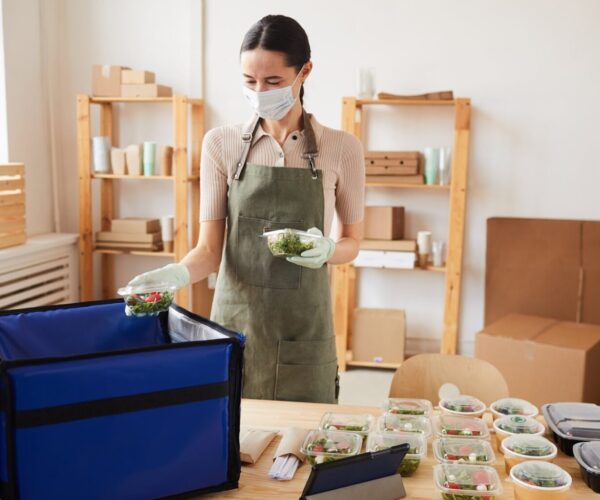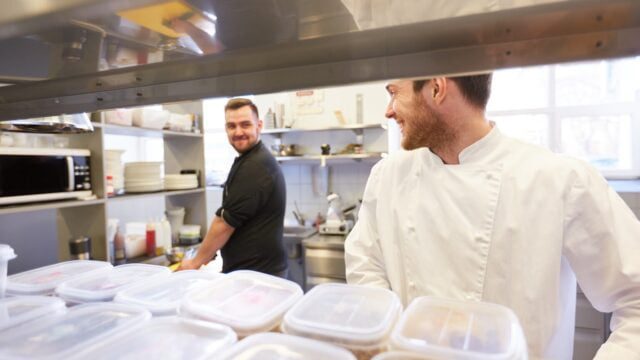Ghost kitchens are the next big thing in the restaurant industry. With restaurant delivery sales increasing substantially over the last few years and especially now given the current sanitary crisis, this delivery-only model has allowed businesses to expand and achieve high margins.
However, just like any other business, ghost kitchens require proper strategies and in depth marketing research to ensure their success. You might have the best food out there, but without the right communication strategy and marketing tools, you will not be able to amplify your reach. In this article, we discuss the top 10 tips and secrets to help you run a successful virtual restaurant.
What is a digital kitchen?
Put simply, a digital kitchen is a delivery only restaurant. It’s a food preparation and cooking facility that operates almost entirely online. It does not have any physical space for customers. Orders are prepared, picked up by a delivery driver or by customers (if a take-away option is available) and then set off for delivery.
Customers can order food from these ghost kitchens online either through their websites, mobile apps or third-party delivery apps such as Deliveroo or UberEats. Many entrepreneurs are choosing to set up ghost kitchens to start their own brand because they allow huge savings in time and money.
Setting up a digital kitchen requires less capital because you don’t have to spend money on decoration, waitstaff or furniture and your business doesn’t have to be located in an overpriced, heavy traffic area like traditional restaurants. In fact, suggest that ghost kitchens can pay up to 40% less in operating expenses compared to restaurants with dine-in areas.
Plus, with help from profitability experts, you can get your digital kitchen running in just a few weeks.
Want the best of both worlds?
Find out how UEAT HUB enables you to sell directly to customers and efficiently take advantage of food delivery apps. No extra labor or tablets required.
Why are ghost kitchens the next big thing?
The ghost kitchen business model is one that is very profitable and exciting for any entrepreneur or business owner. Here are some key advantages of running a ghost kitchen ;
1. Food delivery is exploding
The way people consume food is constantly changing, and while foot traffic and dine-in are still up and running, food delivery is booming more than ever. In fact, due to their busy schedules and the convenience of ordering food, 52 percent of adults claim that ordering takeout or delivery is an essential part of their lifestyle.
Ghost kitchens highly benefit from this trend since they are specifically made for off-premise eating and delivery service. Moreover, third-party delivery platforms open up a massive new channel for ghost kitchens to access new customers and grow. Delivery partners allow restaurants to reach a whole new segment of clients, increasing their potential revenue and optimizing their costs.
2. Costs are unprecedentedly low
Opening a ghost kitchen is cost-effective and a great option for emerging entrepreneurs that want to develop their business but might not have a fair amount of money on hand. The initial costs of a ghost kitchen are considerably lower compared to those of a typical brick and mortar restaurant. In fact, a ghost kitchen generally doesn’t require construction or renovation work which usually eats up a big chunk of the budget.
Moreover ghost kitchen operators often have primary kitchen appliances already installed, so you just need to purchase specific appliances or tools to optimize your production. With the costs being on the lower side, a ghost kitchen gives you the chance to invest your funds in more important areas. You can use it to implement your own online ordering system, increase your marketing efforts or expand your business model in other geographical locations.
3. Bigger margins
Unlike most restaurants that have a diverse menu that aims to satisfy a variety of clients, ghost kitchens perform best with limited niche menus. Smaller and more specific menus mean simpler purchasing, more effective production and bigger margins. Traditional restaurants make an average of 4 to 5 % margin on food and ghost kitchens that know how to optimize food costs can raise that to 7 or 8 %, which in the long term can impact the business immensely.
10 tips to run a successful ghost kitchen
Managing a ghost kitchen is not a simple task. From taking orders to preparing them and delivering them on time, plus promoting and marketing your brand, there is a lot to do. And in order to do it successfully, ghost kitchen operators should have streamlined systems and procedures in place.
1. Manage orders centrally
The entire ghost kitchen business relies heavily on receiving orders from customers through online platforms like websites, mobile apps, call center panels, third party food delivery services, social media… Managing all orders manually can quickly become an issue and cause a lot of problems such as delays and order errors.
In this sense, technology and automation tools play a crucial role to ensure operational efficiency and avoid mistakes. It’s best to invest in a centralized POS that allows you to keep track of your orders coming in from multiple sources and channels.
Not only does this help you prepare faster and accurate food orders but it also minimizes manual effort and the risks of miscommunication. Plus, you can access your business data in real-time to support decision-making and increase your profits and efficiency.
2. Optimize food delivery operations
The delivery business is all about volume and time efficiency, so in order to be successful and achieve customer satisfaction, you have to implement efficient processes and better reporting workflows to ensure utmost accuracy and organization in your delivery orders. There is nothing worse for a client than to get a delayed or inaccurate delivery.
Starting when you receive the order to the preparation and delivery, you need to make sure to optimize the time it takes to fulfill each one of these steps. Defining some standardized operating procedures and investing in automated tools can help you streamline operations and ensure a speedy delivery.
Third-party food services also play a major role in this so you need to make sure that they are correctly listing your restaurant and that the delivery drivers are well versed in the routes of your delivery areas. You should also consider setting up your own online ordering and delivery system via your website and/or mobile app to maximize the volume of orders and reduce your commissions from third delivery apps.
Want the best of both worlds?
Find out how UEAT HUB enables you to sell directly to customers and efficiently take advantage of food delivery apps. No extra labor or tablets required.
3. Provide quality service
Providing great service and experience to your customers is the main goal of every business. This becomes even more important when you’re running a ghost kitchen considering that you barely have any scope to directly interact with your customers. Your digital kitchen can deliver exceptional service by taking care of the basics such as investing in packaging that maintains the temperature of your food and communicates your brand’s vision.
Provide adequate packaging and sealed containers for food delivery and remember to equip your delivery team with the right insulated food bags that maintain the temperature of the food. It’s also important to take into consideration any request from customers (use less salt, add extra condiments, etc.). These simple tips can really make the difference for your ghost restaurant.
4. Do social media promotions
Social media and online advertising can do wonders and help you build a reputation around your brand and attract new customers. Creating content online is a great way of engaging with your customers, getting to know them and therefore, effectively promoting your brand to them.
Using Instagram or Facebook to showcase eye-catching visuals like pictures of your scrumptious dishes, fun videos, behind-the-scenes moments and so on increases engagement rates and entices customers into trying out your food.
You could also use these platforms for online advertising to attract traffic to your website, advertise promotions or special offers currently available and more. Make sure to include an easy way to order or download content with one click.
Download your free marketing guide
5. Create an appealing website
Your website is the window of your brand; it gives your potential customers an overall picture of your business. It’s important to spend extra time on making your website visually appealing and fully functional to take orders. There are different platforms like Squarespace which allow you to create and personalize your website easily.
Make sure to include appealing menus, pictures and videos of your dishes, seamless checkouts, customers’ reviews and more. Adding call to actions (CTAs) such as order now or download menu may encourage your visitors to take action.
Furthermore, you can set up a blog within your website to engage with your customers. Your blog posts are an indirect way to promote your brand and show your customers you’re an expert in your field. You can post new menu items, stories about one of your staff members, your monthly theme… the possibilities are endless. By doing this, you add a personal touch to your business, fortify your online presence and build long-lasting connections with your customers.
How to Integrate Delivery on Your Own Website
6. Online listings and referrals
Nowadays, it’s very unlikely that someone will order from a restaurant without previously doing a quick Google search. You should therefore list your restaurant on top restaurant review platforms (Yelp, Trip Advisor, etc.) and create a Google my Business Account to appear in local searches. This way, customers will be able to find you easily and you will be able to receive ratings and reviews to boost your reputation.
7. Managing reviews
Reviews are an effective way to analyze your customers’ perception of your brand and get immediate feedback. Whether they are good or bad, reviews should always be taken seriously and be answered proactively.
What a customer is saying about you online matters to your potential clientele. If a customer is happy with your service and takes the time to leave you a positive review, you should thank them for their support and appreciation. But most importantly, if a customer is unhappy, try to give them an explanation or just let them know the issue will be addressed immediately.
Using your customer’s feedback can help you detect ongoing issues or areas of improvement and it will show your customers that you care about them and are willing to always offer them the best experience.
8. Create a newsletter
If you have access to your customer’s email address or phone number, you can use these channels to keep them updated about your new offers or promotions. This can be done on a weekly or monthly basis to remind them to order again or get them engaged with a special offer. Just be careful not to spam them as this can have the opposite effect. Try to be innovative and smart with your messages. Before pressing on “send”, challenge yourself and answer the following question: “would I read this email if it was sent by another brand?”
9. Packaging and branding
As mentioned earlier, investing in quality packaging and having strong branding will help you make your ghost kitchen stand out. When it comes to branding, you want to make sure that your brand tells a captivating story that you can use to communicate with your customers and pique their interest. Customers should be able to relate and connect with your story. Also, everyone likes nice things so investing in quality packaging and adding your own logo or design will not only satisfy your customers but also attract potential customers.
10. Use influencer marketing
Influencers are becoming a key element of restaurant marketing strategies. They can give your digital restaurant huge exposure and visibility, whether it be to your target market or a new client segment that you are trying to reach. Every post they make is seen by thousands of followers who trust their opinion and look up to them for recommendations so a single post or story could easily make new customers order from your business.
Before you collaborate with an influencer, make sure to define a few metrics such as the audience reach, average post or story engagement, number of active followers, etc. This will help you better understand the reach of each influencer and measure the ROI of a possible collaboration.

Subscribe to our newsletter for the latest insights in restaurant management
By clicking the button above, you agree that UEAT will use your information to contact you about relevant products, content and events. You can unsubscribe from these communications at any time. For more information, see our Privacy Policy.



